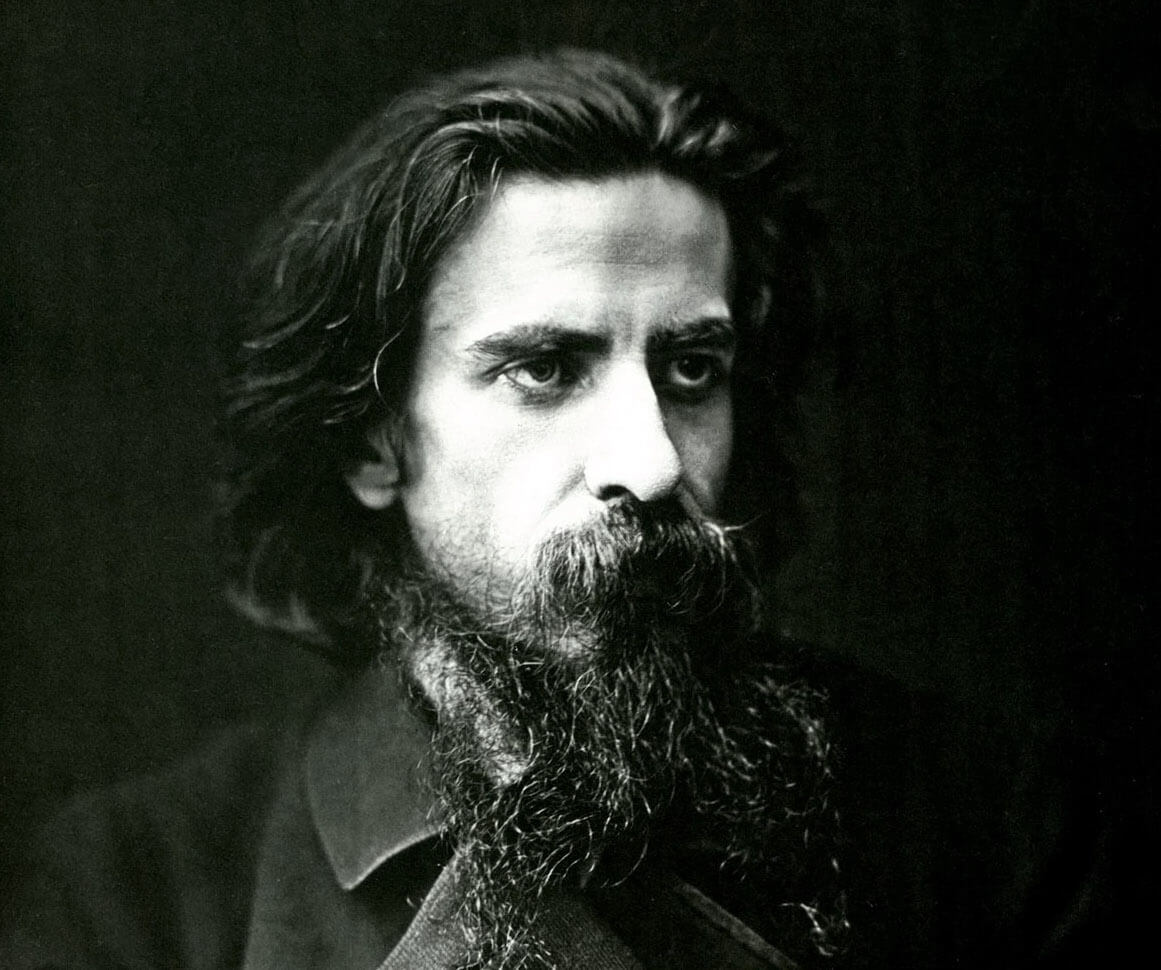Above: Vladimir Solovyov (1853-1900), Russia’s greatest philosopher.
I will never forget my encounter with Vladimir Solovyov over ten years ago. I was living in an apartment with my Russian Orthodox friend and a few others. I was Antiochian Orthodox but we were both hoping to become Orthodox monks. We would pray the long monastic prayers from the Octoechos and burn beeswax candles with lots of incense in our icon corners.
But something was happening in me.
I had recently discovered the truth about “the Orthodox Church.” The truth is that there is no Orthodox Church, only churches.
Very few Orthodox – especially Protestant converts like myself – discover this. The reason, in my experience, is because individual parishes are isolated from one another and individual souls are isolated from other priests and bishops other than one’s own spiritual father. As a result there are “many popes” in Orthodoxy in the form of multiple spiritual fathers giving their own “decrees” on universally controversial matters like contraception and divorce and remarriage.
But if a single Orthodox Christian is not exposed to multiple spiritual fathers – which is quite rare as one is supposed to remain loyal to one’s own spiritual father – this reality will not become apparent.
My friend, whom I shall call Frederick, was a member of a small Russian Orthodox parish in my city which was very isolated from the rest of the Orthodox community in the city. Although were hoping to become monks, we attended separate Orthodox parishes.
I was among the Antiochian Orthodox and had been exposed to two different spiritual fathers as a result of my own history of conversion from Protestantism to Orthodoxy back in 2010. Frederick had not had the same experience. But years ago, he had looked into Catholicism and bought a few of their apologetic books and had them on his shelf. I told him that I was having doubts about Orthodoxy due to the naked revelation of internal disunity and corruption among the Antiochians, which opened up larger, troubling questions of ecclesiology among the Orthodox (I will treat this in detail in a forthcoming book against the Greek schisms). As would be monk brothers, we talked about these issues frequently and discussed all sorts of things while eating our Lenten lentils.
“There’s a Russian Catholic book I have that might speak to that,” he said one day at the dinner table.
“Wait, what?” I said, “Russian Catholic?”
“Yeah let me see,” and he went back into his room to grab the book. “Here.”
He placed a book in front of me with the title The Russian Church and the Papacy. I looked down and saw the publisher: “Catholic Answers.”
Never heard of them.
“Preface by Scott Hahn.” Never heard of him.
Author: “Vladimir Soloviev.” Never heard of him.
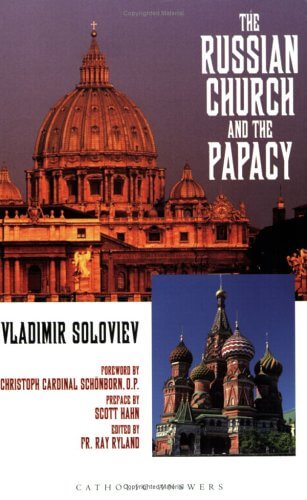
I opened up the text – and stayed up late into the night reading, finishing the book in 24 hours.
It was like St. Teresa Benedicta a Cruce reading the biography of St. Teresa of Avila and immediately requesting baptism. I was struck by a moving train that left my heart and soul flattened.
Vladimir Solovyov took the experience I had and penetrated the depths of the problem of the Greek schisms – ethnophyletism. Among the good Orthodox scholars, they themselves admit that this is the main issue with their churches. Greek Orthodox Metropolitan John Zizioulas of happy memory calls this “autocephalism” as something akin to an ecclesiological heresy,
as a result [of which], relations among the ‘sister churches’ tend to resemble more and more the relations between sovereign states, all the more so as a strong dose of nationalism (condemned in 1872 as “phyletism,” which paradoxically all unanimously denounce as a heresy and many, at the same time, profess it in practice) is mixed with this notion of “independence.”[1]
This is the reality that I had experienced as an Antiochian Orthodox Christian seeing the difference in dogma between different spiritual fathers within the same Antiochian church. What Solovyov did was push the roots of this problem back to the first millennium. He revealed the worship of the pagan goddess Roma and the pagan priesthood of pontifex maximus adhering to the Christian Roman Emperors of the east, and how this, and not the alleged self-aggrandizement of the Papacy was at the root of the Greek schisms (the history of the papacy did include these self-aggrandizements, but this was not so much a first millennium problem as the second, as we discuss here at OnePeterFive).
The true reality of the Orthodox churches is described with lucidity by Solovyov from within the Russian Orthodox Church way back in 1889.
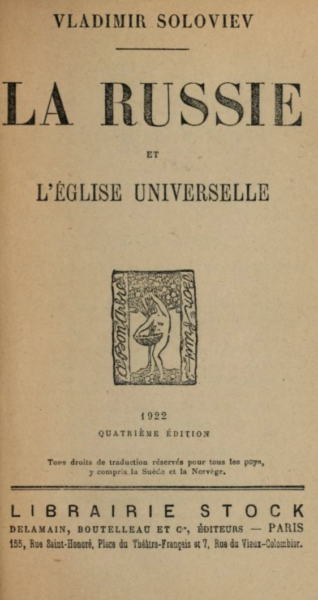
In his powerful introduction to the work (the aforementioned is actually an abridged version of the entire work Russia and the Universal Church available online here), he describes three main parties at work in the Church in the first millennium: first, there were the notorious heretics, whom everyone knows by name, and all the Roman emperors who supported them. Then there were the true Orthodox:
[This true Orthodox party] relied on the greatest religious force of those times, the monks, and also on the simple faith of the mass of devout believers, at least in the central parts of the Byzantine Empire. Moreover, these orthodox Catholics found and recognized in the central Chair of St. Peter the mighty palladium of religious truth and freedom. To indicate the moral weight and ecclesiastical importance of this party, it is enough to say that it was the party of St. Athanasius the Great, of St. John Chrysostom, of St. Flavian, of St. Maximus the Confessor and of St. Theodore of the Studium.[2]
This party consisted of all pious and Orthodox Catholics whether Latin, Greek, Syriac, or some other tongue, scattered around the Roman Empire and her borders from Spain to Persia. The Orthodox apologists today claim that the Orthodox churches are the heir to this party. However, this is not the case, a Solovyov makes clear. Rather, there is a third party, neither heretical nor truly Orthodox, but “Orthodox in name only.” Solovyov’s potent description of this party deserves a thorough quotation from the Russian Master:
[It] was neither the declared heretics nor the genuinely orthodox who controlled for many centuries the destinies of the Christian East. The decisive part in the story was played by a third party which, although it occupied an intermediate position between the other two, was distinguished from them by more than mere verbal subtleties; it had a clearly defined aim and pursued a well-considered policy. The great majority of the higher Greek clergy belonged to this party, which we may call semi-orthodox or rather “orthodox-anticatholic.”
These priests held firmly to orthodox dogma, either from theoretical conviction or from force of habit or from devotion to the common tradition. They had nothing in principle against the unity of the universal Church, provided only that the center of that unity was situated in their midst; and since in point of fact this center was situated elsewhere, they preferred to be Greeks rather than Christians and accepted a divided Church rather than the Church unified by a power which was in their eyes foreign and hostile to their nationality. As Christians, they could not be Cæsaropapists in principle, but as patriotic Greeks first and foremost, they preferred the Byzantine Cæsaropapism to the Roman Papacy.
Unluckily for them the Greek autocrats distinguished themselves for the most part as the champions or even as the authors of heresy; and what they found still more intolerable was that the rare occasions when the Emperors took orthodoxy under their protection were exactly the occasions when the Empire and the Papacy were in accord with one another. To disturb this accord and to attach the Emperors to orthodoxy while weaning them from Catholicism was the chief aim of the Greek hierarchy. In pursuit of this aim they were ready, despite their sincere orthodoxy, to make sacrifices even on questions of dogma.
Formal and explicit heresy was regarded with horror by these pious gentlemen, but when it pleased the divine Cæsar to offer them his own version of orthodox dogma, they did not scrutinize it too closely. They preferred to receive a revised or incomplete formula at the hands of a Greek Emperor rather than accept the truth pure and intact from the mouth of a Pope; they were glad to see Zeno’s henoticon replace the dogmatic epistle of St. Leo the Great. In the six or seven successive episodes in the history of the Eastern heresies, the policy of the pseudo-orthodox party was always the same. When heresy in its first flush of victory was being thrust upon them with violence, these prudent people, having a pronounced distaste for martyrdom, gave way, though unwillingly.
Thanks to their passive support, the heretics were able to convene general assemblies as large as, or even larger than, the true œcumenical councils. But when the blood of confessors, the fidelity of the mass of the people, and the threatening authority of the Roman pontiff had compelled the imperial power to forsake the cause of error, these unwilling heretics returned en masse to orthodoxy and, like the laborers hired at the eleventh hour, received their full pay. The heroic confessors seldom survived the persecutions, and it was the worldly-wise who enjoyed the victory of Truth.
They formed the majority in the orthodox councils, as they had previously in the heretical conventions; and though they could not refuse concurrence to the Pope’s representatives when he sent them a precise and definite formulation of orthodox dogma, though at the first they even expressed their concurrence with more or less sincere enthusiasm, the evident triumph of the Papacy soon brought them back to their prevailing sentiment of jealous hatred toward the apostolic see, and they proceeded to use all the efforts of a determined will and all the resources of an astute intelligence to counterbalance the success of the Papacy, to rob it of its rightful influence and to set up in opposition to it an unreal and usurped authority.
The Pope had been useful in dealing with heresy; but once heresy was done with, what need was there of the Pope? Could not the patriarch of the old Rome be replaced by the patriarch of the new? Thus each triumph of orthodoxy, which was always the triumph of the Papacy, was invariably followed at Byzantium by an anti-Catholic reaction into which the sincere but short-sighted champions of orthodoxy were also drawn. This separatist reaction would last until a new heresy, more or less favored by the imperial power, supervened to disturb orthodox consciences and remind them of the advantage of a genuine ecclesiastical authority.[3]
This summary of the first century controversies lit up my brain like lightning on a dark night. I was floored. This was precisely the issue, and this is what explains so much of the first millennium controversies! (For readers who need more footnotes to substantiate these claims, I recommend E. Ybarra’s definitive work on the first millennium Papacy controversies, published by St. Paul Center: The Papacy).
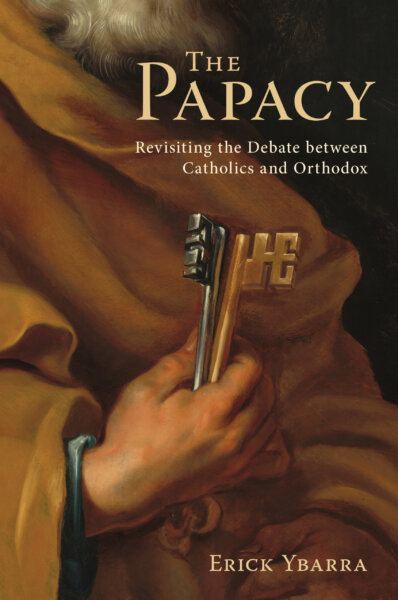
(Now we should be clear in passing here that many – most! – devout members of Orthodox churches today do indeed belong to the true Orthodox party as they piously work out their salvation through the Sacramental grace received among the Apostolic Churches. They are utterly ignorant – and uninterested! – in controversies between east and west, and only want to be true and orthodox Christians and save their souls. These are those whom Solovyov calls “the true Orthodoxy of the Russian people.”[4] These faithful have been victimized by the schismatic clergy who orchestrated this schism with Rome, and the Raskol was a popular reaction to this Czarist tyranny, which is why Solovyov speaks of the “relative truth of the Raskol.”[5])
Solovyov dismantled all the façade of “the Orthodox Church” and uncovered the nakedness of the shameful Greek schisms, and their hubris in their own nationality, especially in Russia, buttressed by a new form of the goddess Roma: the mythology of “Third Rome,” which was taught by Russian saints to the Czars.
This is why Solovyov predicted the current schism between “New Rome” (Constantinople) and “Third Rome” (Moscow) with these words written more than one hundred years before it happened in 2018:
[O]n the day on which the Russian and Greek Churches formally break with one another the whole world will see that the Ecumenical Eastern Church is a mere fiction and that there exists in the East nothing but isolated national Churches.[6]
Solovyov maintains – correctly – that these isolated national Churches have existed since the fall of Constantinople, and we can even date it back to when the Miaphysites began their revolt against the Roman empire as a sort of ethnic counter-revolution.[7]
After I encountered Solovyov, all the Greek schisms were exposed in their reality and the clear need for the Romanitas that God’s providence had provided was proved.
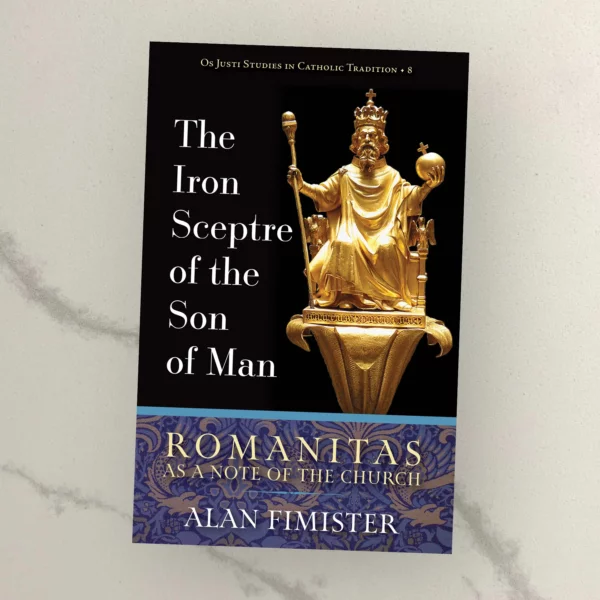
I suddenly looked at Rome and never looked back. In 2013, shortly after Pope Francis was elected, I came into communion with Rome and have never once regretted it, because I’ve tried to live without it, and its worse than Pope Francis.
As for Solovyov, as a Russian Orthodox Christian, he too came into communion with Rome and became the godfather of the Russian Catholic Church of the Byzantine rite. There is, however, much controversy about Solovyov’s death. But that is another story that will be treated in another article by our Russian Catholic contributor Maxim Grigorieff. For now, we will next publish an extremely important excerpt from Russia and the Universal Church which has great relevance for our time. Stay tuned for more in the next article.
[1] John Zizioulas, “Primacy in the Church: An Orthodox Approach” in Petrine Ministry and the Unity of the Church (ed. Puglisi), 129.
[2] Vladimir Soloviev, Russia and the Universal Church, trans. Rees (London: Centenary Press, 1948), 18.
[3] Ibid., 18-19.
[4] Ibid., 46-50.
[5] Ibid., 51-55.
[6] Ibid., 67.
[7] See Fr. John Meyendorff, Imperial Unity and Christian Division (SVS Press, 2011).

